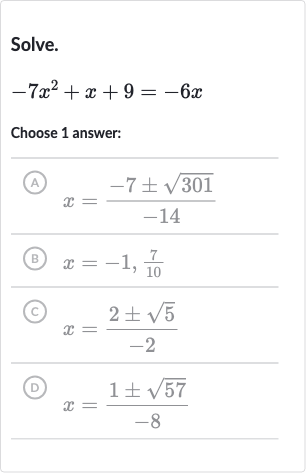AI tutor
Full solution
Q. Solve.Choose answer:(A) (B) (C) (D)
- Moving terms to one side: First, we need to move all terms to one side of the equation to set it equal to zero.Add to both sides to get:
- Identifying coefficients: Now, we identify the coefficients , , and in the quadratic equation .In our equation, , we have:
- Using the quadratic formula: Next, we use the quadratic formula to find the solutions for :Substitute , , and into the formula.
- Calculating the discriminant: Now, we calculate the discriminant (the part under the square root):Discriminant = Discriminant = Discriminant = Discriminant =
- Substituting the discriminant: We substitute the discriminant back into the quadratic formula:
- Simplifying the expression: Finally, we simplify the expression: or These are the solutions in the simplest radical form.
More problems from Solve a quadratic equation using the quadratic formula
QuestionGet tutor help
QuestionGet tutor help
QuestionGet tutor help
QuestionGet tutor help
QuestionGet tutor help
QuestionGet tutor help
QuestionGet tutor help
QuestionGet tutor help

